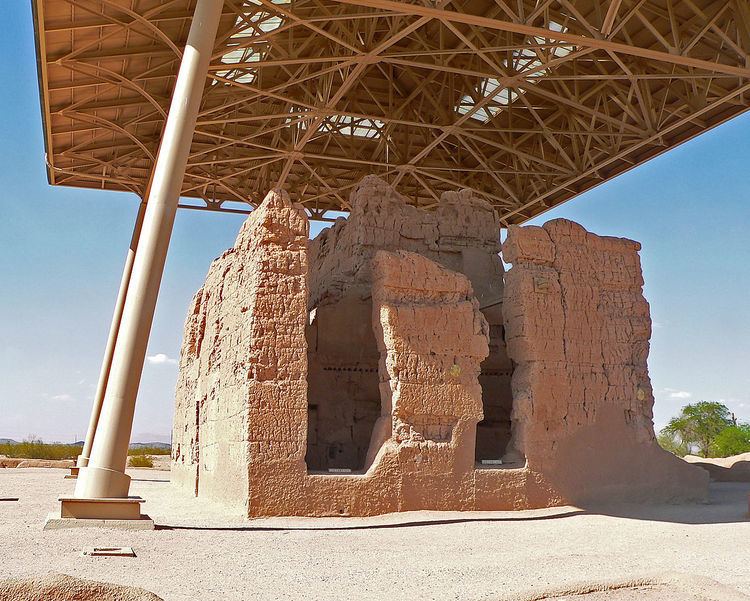Phone +1 520-723-3172 Added to NRHP 15 October 1966 | Visitors 65,106 (in 2013) Area 191 ha | |
 | ||
Created August 3, 1918 (1918-August-03) Website Casa Grande Ruins National Monument Address 1100 W Ruins Dr, Coolidge, AZ 85128, USA Hours Closing soon · 9AM–5PMSunday9AM–5PMMonday9AM–5PMTuesday9AM–5PMWednesday9AM–5PMThursday9AM–5PMFriday9AM–5PMSaturday9AM–5PM Similar Tonto National Monument, Wupatki National Monument, Tuzigoot National Monument, Montezuma Castle National, Hohokam Pima National Profiles | ||
Casa Grande Ruins National Monument (O'odham: Siwañ Waʼa Ki: or Sivan Vahki), in Coolidge, Arizona, just northeast of the city of Casa Grande, preserves a group of Ancient Pueblo Peoples Hohokam structures of the Pueblo III and Pueblo IV Eras.
Contents
- Casa grande ruins national monument national park service
- Ancient pueblosEdit
- Administrative historyEdit
- Historic adobesEdit
- Olmsted shelterEdit
- References
Casa grande ruins national monument national park service
Ancient pueblosEdit
The national monument consists of the ruins of multiple structures surrounded by a compound wall constructed by the ancient people of the Hohokam period, who farmed the Gila Valley in the early 13th century. "Archeologists have discovered evidence that the ancient Sonoran Desert people who built the Casa Grande also developed wide-scale irrigation farming and extensive trade connections which lasted over a thousand years until about 1450 C.E."
"Casa Grande" is Italian and Spanish for "big house" (Siwañ Wa'a Ki: in O'odham); these names refer to the largest structure on the site, which is what remains of a four story structure that may have been abandoned by 1450. The structure is made of caliche, and has managed to survive the extreme weather conditions for about seven centuries. The large house consists of outer rooms surrounding an inner structure. The outer rooms are all three stories high, while the inner structure is four stories high. The structures were constructed using traditional adobe processes. The wet adobe is thicker at the base and adds significant strength. Horizontal cracks can be noticed and this defines the breaks between courses on the thick outer walls. The process consisted of using damp adobe to form the walls and then waiting for it to dry, and then building it up with more adobe. Casa Grande contained a ball court much like that found at Pueblo Grande de Nevada. Father Eusebio Kino was the first European to view the Hohokam complex in November 1694 and named it Casa Grande. Graffiti from 19th-century passers-by is scratched into its walls; though this is now illegal. Casa Grande now has a distinctive modern roof covering built in 1932.
Administrative historyEdit
In 1891, the monument underwent repairs supervised by Cosmos Mindeleff of the Bureau of American Ethnology, until funds ran out. Proclaimed Casa Grande Reservation by an order of President Benjamin Harrison on June 22, 1892, Casa Grande Ruins became the first prehistoric and cultural reserve in the US. It was then re-designated a national monument by President Woodrow Wilson on August 3, 1918. As with all historical areas administered by the National Park Service, Casa Grande was listed on the National Register of Historic Places on October 15, 1966.
Historic adobesEdit
Between 1937 and 1940 the Civilian Conservation Corps built several adobe buildings to serve as housing and administrative offices for the National Monument. The adobe buildings, constructed using traditional methods, continue in use today and are now listed on the National Register of Historic Places. Because of careful conservation, the physical appearance of Casa Grande Ruins has hardly changed since the 1940s.
Olmsted shelterEdit
In 1932, a ramada was built to shelter the ruins from weathering by Boston architect Frederick Law Olmsted, Jr. In the early 21st century, a pair of Great horned owls took up residence in the rafters of the Olmsted shelter.
The current protective structure covering the "Great House" replaced a wooden similar structure built to protect it in 1932. Due to the fragile nature of the "Great House", visitors to the site are not permitted inside. Observation is permitted outside the structure only for visitors to protect its integrity.
